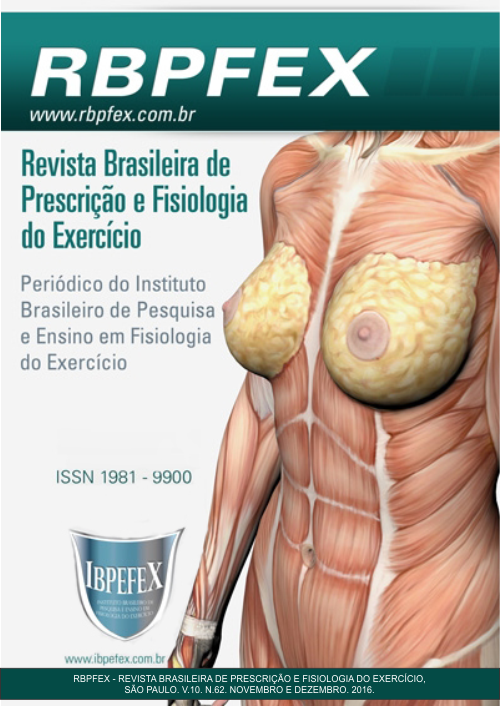Profile of quality of life and physical activity of participants in adults participants of physical education class of Education of Youths and Adults (EJA)
Abstract
The present study aims to describe the quality of life profile (QL) and physical activity (PA) to the adults participating in physical education of youth and adult education, from the application of the SF-36 and Baecke modified questionnaires, respectively. The sample has a high level of home activities and QL in the areas of physical, functional capacity, social and emotional aspects. However, the levels as the vitality and general health have lower than the other levels. Therefore, the fact that individuals exhibit a high level of physical activity appears to influence in only some areas of QL. Thus, QL is influenced by multiple factors and different in different populations.
References
-Alves Junior, E. D.; Melo, V. A. Introdução ao lazer. São Paulo. Manole. 2012.
-Alves Junior, E.D. (org) Envelhecimento e vida saudável 1. Rio de Janeiro. Apicuri. 2009.
-Alves Junior,E. D. (org) Envelhecimento e vida saudável 1. Rio de Janeiro. Apicuri. 2010.
-Brandão, C. R. O Que é Educação. São Paulo. Brasiliense.1995.
-Brasil. Senado Federal. Lei de Diretrizes e Bases da Educação Nacional nº 9394/96, de 20 de dezembro de 1996.Brasília: 1996. Disponível em: <http://www.planalto.gov.br>.
-Chyun, D. A.; e colaboradores. The association of psychological factors, physical activity, neuropathy, and quality of life in type 2 diabetes. Biol Res Nurs. Vol. 7. Núm. 4. p. 279-288. 2006.
-Farinatti P. T. V.; Ferreira M. S. Saúde, promoção da saúde e educação física. Rio de Janeiro. Editora da UERJ. 2006.
-Ferreira, M.S. Agite Antes de Usar... A Promoção da Saúde em Programas Brasileiros de Promoção da Atividade Física: o caso do Agita São Paulo. Dissertação. Doutorado em Ciências da Saúde Pública. Escola Nacional de Saúde Pública Sérgio Arouca-Ensp/Fiocruz, Rio de Janeiro. 2008.
-Garratt, A. M.; e colaboradores. The SF36 health survey questionnaire: An outcome measure suitable for routine use within the nhs? Bmj. Vol. 306. Núm. 6890. p. 1440-1444. 1993.
-Melo, V. A. D. Esporte e lazer –Conceitos uma introdução histórica. Rio de Janeiro: Apicuri. 2006.
-Minayo,M.C.S.; e colaboradores. Qualidade de vida e saúde: um debate necessário. Ciência & Saúde Coletiva. Vol. 5. Núm. 1. p. 7-18. 2000.
-Naiff, L. A. M.; Naiff, D. G. M. Educação de jovens e adultos em uma análise psicossocial: representações e práticas sociais. Psicologia & Sociedade. Vol. 20. Núm. 3. 2008.
-Pucci, G. C. M. F.; e colaboradores. Associação entre atividade física e qualidade de vida em adultos. Rev Saúde Pública. Vol. 46. Núm. 1. p. 166-179. 2012. Disponível em: .
-Sampaio, M. Educação de jovens e adultos: uma história de complexidade e tensões. Práxis Educacional. Vitória da Conquista. Vol. 5. Núm. 7. p. 13-27. 2009.
-Scliar, M. História do Conceito de Saúde. PHYSIS: Rev. Saúde Coletiva. Vol. 17. Núm. 1. p. 29-41. 2007.
-Smith, K. M.; e colaboradores. Differences in sustainability of exercise and health related quality of life outcomes following home or hospital-based cardiac rehabilitation. Eur J Cardiovasc Prev Rehabil.FESC. Vol. 11. Núm. 4. p. 313-319. 2004.
-Soares, L. Educação de Jovens e Adultos. Rio de Janeiro: DP&A, 2002.
-Spirduso, W. W.; Cronin, D.L.Exercise dose-response effects on quality of life and independent living in older adults. Medicine & Science in Sports & Exercise. Indianapolis. Vol. 33. Núm. 6. p. 598-608. 1991.
-Vilanova, R.; Martins, I. Educação em Ciências e educação de jovens e adultos: pela necessidade do diálogo entre campos e práticas. Ciência& Educação. Vol. 14. Núm. 2. p. 331-346. 2008.
-Voorrips, L. E.; e colaboradores. A physical activity questionnaire for the elderly. Medicine & Science in Sports & Exercise. Vol. 23. Núm. 8. p. 974-979. 1991.
-WHOQOL, Group. The Ottawa Charter for Health Promotion. Switzerland. Nov. 1984. Disponível em:<http://www.who.int/en>.
-WHOQOL, Group. The World Health Organization Quality of Life assessment (WHOQOL): position paper from the World Health Organization. Soc Sci Med. Vol. 41. Núm. 10. p. 1403-1409. 1995. Disponível em: <http://www.who.int/en>.
Authors who publish in this journal agree to the following terms:
- Authors retain the copyright and grant the journal the right of first publication, with work simultaneously licensed under the Creative Commons Attribution License BY-NC which allows the sharing of the work with acknowledgment of the authorship of the work and initial publication in this journal.
- Authors are authorized to enter into additional contracts separately for non-exclusive distribution of the version of the work published in this journal (eg, publishing in institutional repository or book chapter), with acknowledgment of authorship and initial publication in this journal.
- Authors are allowed and encouraged to post and distribute their work online (eg, in institutional repositories or on their personal page) at any point before or during the editorial process, as this can bring about productive change as well as increase impact and impact. citation of published work (See The Effect of Free Access).






